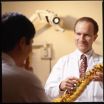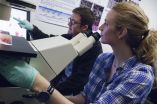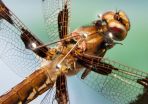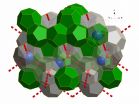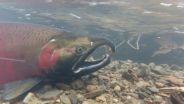(Press-News.org) Many children who sustain so-called open bone fractures in the forearm or lower leg can, and do, heal safely without surgery, according to the results of a small study led by investigators at the Johns Hopkins Children's Center.
Open fractures occur when the broken bone protrudes through the skin, causing a puncture wound.
The study, published ahead of print in the Journal of Children's Orthopaedics, shows that when the wound is small -- less ½-inch in diameter -- and the surrounding tissue is free of visible contamination with dirt or debris, children heal well on their own.
The results, based on analysis of outcomes among 40 pediatric patients ages 4 to 16 with such clean open-bone fractures treated nonsurgically at Johns Hopkins between 2000 and 2013, showed normal bone healing and no long-term complications.
The study findings challenge the prevailing clinical dogma that calls for preemptive surgery on every pediatric fracture, the researchers say, and highlight the tendency of clean open bone breaks -- known as type one fractures in medical speak -- to heal on their own without infection or complications.
"Not all pediatric fractures are created equal and our findings indicate that when it comes to simple, clean open breaks, which are very common in kids, a minimalistic 'clean, set the bone and watch' approach could be just as effective as more aggressive surgical treatment," says study senior investigator Paul Sponseller, M.D., M.B.A., director of pediatric orthopaedics at the Johns Hopkins Children's Center. "We believe our results set the stage for a larger study to settle the long-standing debate on this issue once and for all."
The traditional surgical approach requires general anesthesia and the surgical creation of a larger opening around the wound to access the bone. The nonsurgical option requires irrigating and cleaning the flesh wound without cutting any further around the break, setting the bone ends together, and casting the limb, all done with the use of local anesthesia in the emergency room.
Besides avoiding the risks associated with general anesthesia and surgery, the nonsurgical approach leads to less scarring and faster recovery. It also lowers the cost of care as a result of shorter hospital stays, outpatient treatment and a simpler technique.
Sponseller and colleagues, however, caution that not all open fractures are good candidates for nonsurgical repair. Those that include damage to surrounding nerves or blood vessels require a more elaborate surgical treatment, as do wounds that are visibly contaminated and in need of surgical removal of affected tissue, the team notes. Cases in which the realignment of the bone is tricky and cannot be achieved without surgery should also be treated operatively, the researchers say.
"The take-home lesson here is that when it comes to pediatric open fractures, a one-size treatment doesn't fit all, and each fracture requires careful clinical evaluation," Sponseller says. "But it is clear to us that surgery is not always the best choice. Nonsurgical approaches should be considered for all kids with simple open bone breaks and no evidence of infection, serious damage or major debris."
The majority of fractures among children in the study were to the radial or ulnar bones of the forearm and to the tibia, or shin bone, of the lower leg. Most children (36 of 40) received intravenous antibiotics while treated in the emergency room. Additionally, 28 of them were sent home with a prescription for a seven-day course of oral antibiotics as a precaution.
At the end of the study, 35 of the 40 patients returned for follow-up exams. All of them healed fine, the team reports. The parents and/or pediatricians of the remaining five children who did not return for follow-up also reported normal outcomes and lack of complications when reached via phone. There was a single minor complication in a 6-year-old child who retained a tiny piece of debris that became encapsulated and inflamed. The encapsulated area was later removed during follow-up without further complications.
Sponseller and his colleagues stop short of calling for a formal change in the current standard of care, but say that if their results are confirmed in a larger trial, they could eventually redefine the treatment of such simple open fractures in children.
INFORMATION:
Ahmed A. Bazzi, an orthopaedic surgeon at the Children's Hospital of Michigan, was the first author on the study.
Other Johns Hopkins investigators involved in the study included Amit Jain, Michael Ain and John Tis. Jaysson T. Brooks, an orthopaedic surgeon at MedStar Good Samaritan Hospital in Baltimore was co-author on the research.
CAMBRIDGE, MA, December 10, 2014 - A team of investigators from the Broad Institute, Massachusetts General Hospital and other leading biomedical research institutions has pinpointed rare mutations in a gene called APOA5 that increase a person's risk of having a heart attack early in life. These mutations disable the APOA5 gene and also raise the levels in the blood of triglyceride-rich lipoproteins, a type of fat. The researchers' findings, together with other recent genetic discoveries -- specifically, the identification of protective mutations in the APOC3 gene that lower ...
Stem cells in early embryos have unlimited potential; they can become any type of cell, and researchers hope to one day harness this rejuvenating power to heal disease and injury. To do so, they must, among other things, figure out how to reliably arrest stem cells in a Peter Pan-like state of indefinite youth and potential. It's clear the right environment can help accomplish this, acting as a sort of Neverland for stem cells. Only now are scientists beginning to understand how.
New collaborative research between scientists at Rockefeller University and Memorial ...
The dragonfly is a swift and efficient hunter. Once it spots its prey, it takes about half a second to swoop beneath an unsuspecting insect and snatch it from the air. Scientists at the Howard Hughes Medical Institute's Janelia Research Campus have used motion-capture techniques to track the details of that chase, and found that a dragonfly's movement is guided by internal models of its own body and the anticipated movement of its prey. Similar internal models are used to guide behavior in humans.
"This highlights the role that internal models play in letting these creatures ...
INDIANAPOLIS -- How do some proteins survive the extreme heat generated when they catalyze reactions that can happen as many as a million times per second? Work by researchers from Indiana University-Purdue University Indianapolis (IUPUI) and the University of California Berkeley published online on Dec. 10 in Nature provides an explosive answer to this important question.
Proteins are essential to the human body, doing the bulk of the work within cells. Proteins are large molecules responsible for the structure, function, and regulation of tissues and organs. Enzymes ...
CORVALLIS, Ore. - Nitrous oxide (N2O) is an important greenhouse gas that doesn't receive as much notoriety as carbon dioxide or methane, but a new study confirms that atmospheric levels of N2O rose significantly as the Earth came out of the last ice age and addresses the cause.
An international team of scientists analyzed air extracted from bubbles enclosed in ancient polar ice from Taylor Glacier in Antarctica, allowing for the reconstruction of the past atmospheric composition. The analysis documented a 30 percent increase in atmospheric nitrous oxide concentrations ...
In a ground-breaking paper published in Nature, they show that the three protein complexes act in relay to regulate cell division: reactivation of one leads to the second becoming active.
Cells rely on control systems to make sure that each aspect of the cell division cycle occurs in the correct order. Following successful segregation of the genomes in mitosis, each must return to its pre-division state in a process called mitotic exit. Mitotic exit is irreversible for all multicellular organisms. Loss of cell cycle control during this process - leading to unregulated ...
Clathrates are now known to store enormous quantities of methane and other gases in the permafrost as well as in vast sediment layers hundreds of metres deep at the bottom of the ocean floor. Their potential decomposition could therefore have significant consequences for our planet, making an improved understanding of their properties a key priority.
In a paper published in Nature this week, scientists from the University of Göttingen and the Institut Laue Langevin (ILL) report on the first empty clathrate of this type, consisting of a framework of water molecules ...
CAMBRIDGE, MA -- Using a gene-editing system originally developed to delete specific genes, MIT researchers have now shown that they can reliably turn on any gene of their choosing in living cells.
This new application for the CRISPR/Cas9 gene-editing system should allow scientists to more easily determine the function of individual genes, according to Feng Zhang, the W.M. Keck Career Development Professor in Biomedical Engineering in MIT's Departments of Brain and Cognitive Sciences and Biological Engineering, and a member of the Broad Institute and MIT's McGovern Institute ...
Anticipated changes in climate will push West Coast marine species from sharks to salmon northward an average of 30 kilometers per decade, shaking up fish communities and shifting fishing grounds, according to a new study published in Progress in Oceanography.
The study suggests that shifting species will likely move into the habitats of other marine life to the north, especially in the Gulf of Alaska and Bering Sea. Some will simultaneously disappear from areas at the southern end of their ranges, especially off Oregon and California.
"As the climate warms, the species ...
For the firefighters and rescue workers conducting the rescue and cleanup operations at Ground Zero from September 2001 to May 2002, exposure to hazardous airborne particles led to a disturbing "WTC cough" -- obstructed airways and inflammatory bronchial hyperactivity -- and acute inflammation of the lungs. At the time, bronchoscopy, the insertion of a fiber optic bronchoscope into the lung, was the only way to obtain lung samples. But this method is highly invasive and impractical for screening large populations.
That motivated Prof. Elizabeth Fireman of Tel Aviv University's ...
